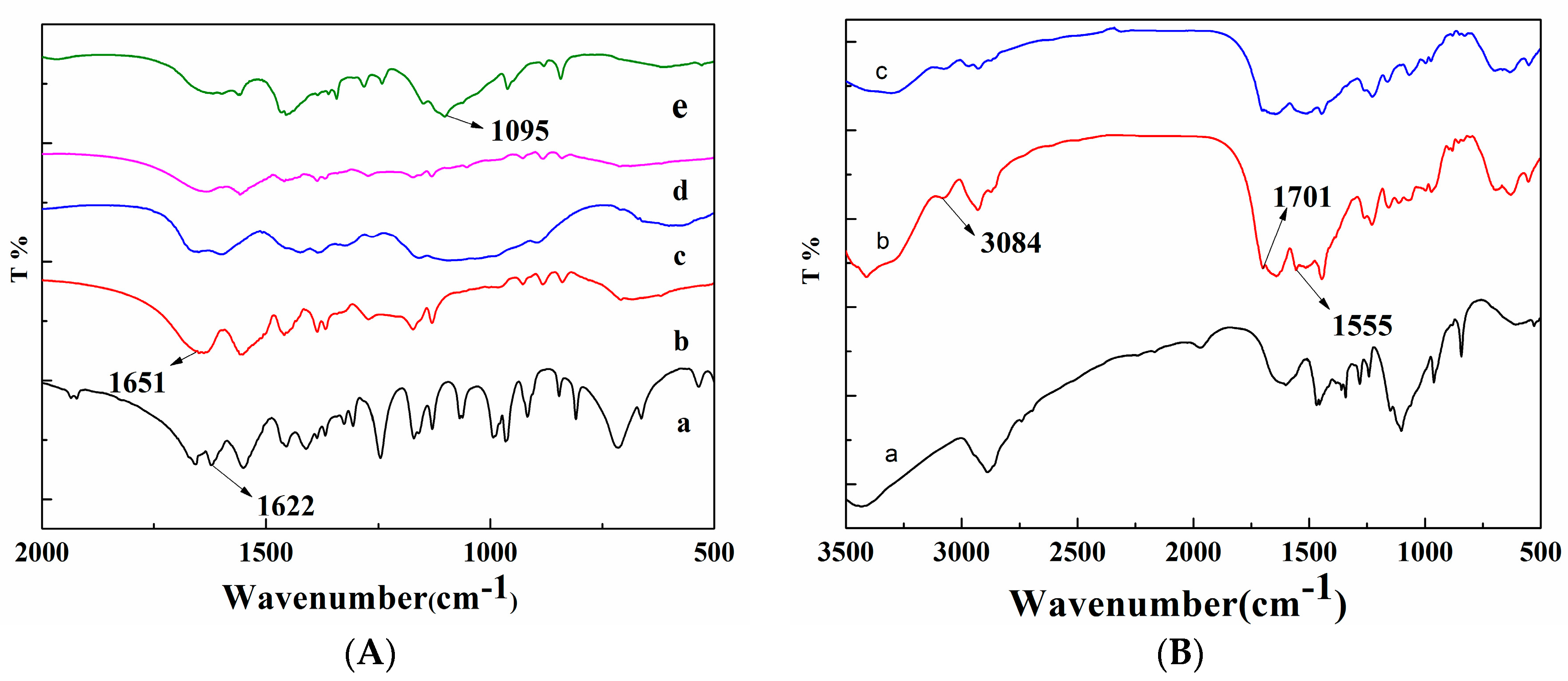Multifunctional Surface Modification of Mulberry Silk Fabric via PNIPAAm/Chitosan/PEO Nanofibers Coating and Cross-Linking Technology
Abstract
:1. Introduction
2. Experimental
2.1. Materials
2.2. Preparation of the Hydrogel and Spinning Solution
2.3. Fabrication of Electrospun Nanofibers
2.4. Functionalization of Mulberry Silk
2.5. Characterization
2.5.1. Hydrogel pH-Responsive Swelling Behaviors
2.5.2. Hydrogel Thermosensitive Behavior Measurements
2.5.3. Scanning Electron Microscopy
2.5.4. Fourier Transform Infrared Spectroscopy
2.5.5. Fabric Contact Angle Measurements
2.5.6. Fabric Air Permeability Measurements
2.5.7. Fabric Antimicrobial Activity Measurements
3. Results and Discussion
3.1. pH-Responsive Swelling Behaviors
3.2. Thermosensitive Behavior
3.3. Morphology of Nanofiber Mats
3.4. FT-IR Spectrum
3.5. Contact Angle
3.6. Air Permeability
3.7. Antimicrobial Activity
4. Conclusions
Acknowledgments
Author Contributions
Conflicts of Interest
References
- Hodak, S.K.; Supasai, T.; Paosawatyanyong, B.; Kamlangklab, K.; Pavarajarnc, V. Enhancement of the hydrophobicity of silk fabrics by SF 6, plasma. Appl. Surf. Sci. 2008, 254, 4744–4749. [Google Scholar] [CrossRef]
- Zhang, J. Silk fabrics modification through plasma graft copolymerization. J. Text. Res. 1996, 4, 1–4. (In Chinese) [Google Scholar]
- Kamlangkla, K.; Hodak, S.K.; Levalois-Grützmacher, J. Multifunctional silk fabrics by means of the plasma induced graft polymerization (PIGP) process. Surf. Coat. Technol. 2011, 205, 3755–3762. [Google Scholar] [CrossRef]
- Paosawatyanyong, B.; Jermsutjarit, P.; Bhanthumnavin, W. Graft copolymerization coating of methacryloyloxyethyl diphenyl phosphate flame retardant onto silk surface. Prog. Org. Coat. 2014, 77, 1585–1590. [Google Scholar]
- Lu, Z.; Zhang, H.; Zhou, M. Nano-functionalized silk for smart wearable devices. Funct. Mater. Inf. 2016, 4, 79. (In Chinese) [Google Scholar]
- Wang, C.; Li, X.; Gao, E.; Jian, M.; Xia, K.; Wang, Q.; Xu, Z.; Ren, T.; Zhang, Y. carbonized silk fabric for ultrastretchable, highly sensitive, and wearable strain sensors. Adv. Mater. 2016, 28, 6640–6648. [Google Scholar] [CrossRef] [PubMed]
- Cheng, C.; Teasdale, I.; Brüggemann, O. Stimuli-responsive capsules prepared from regenerated silk fibroin microspheres. Macromol. Biosci. 2014, 14, 807–816. [Google Scholar] [CrossRef] [PubMed]
- Stuart, M.A.C.; Huck, W.T.; Genzer, J.; Müller, M.; Ober, C.; Stamm, M.; Sukhorukov, G.B.; Szleifer, I.; Tsukruk, V.V.; Urban, M. Emerging applications of stimuli-responsive polymer materials. Nat. Mater. 2010, 9, 101–113. [Google Scholar] [CrossRef] [PubMed]
- Galaev, I.Y.; Mattiasson, B. “Smart” polymers and what they could do in biotechnology and medicine. Trends Biotechnol. 1999, 17, 335–340. [Google Scholar] [CrossRef]
- Schild, H.G. Poly(N-isopropylacrylamide): Experiment, theory and application. Prog. Polym. Sci. 1992, 17, 163–249. [Google Scholar] [CrossRef]
- Zhou, J.-X. Preparation of electromagnetic shielding textiles by sputtering/chemical coating technology. Dyeing Finish. 2008, 5, 1–6. (In Chinese) [Google Scholar]
- Mao, C.; Guo, X.; Shi, D. Discussion on coating technology of wrapped rope in home textiles. Shanghai Text. Sci. Technol. 2011, 29, 27–28. (In Chinese) [Google Scholar]
- Sonehara, M.; Sato, T.; Takasaki, M.; Konishi, H.; Yamasawa, K.; Miura, Y. Preparation and characterization of nanofiber nonwoven textile for electromagnetic wave shielding. IEEE Trans. Magn. 2008, 44, 3107–3110. [Google Scholar] [CrossRef]
- Bhardwaj, N.; Kundu, S.C. Electrospinning: A fascinating fiber fabrication technique. Biotechnol. Adv. 2010, 28, 325–347. [Google Scholar] [CrossRef] [PubMed]
- Greiner, A.; Wendorff, J.H. Electrospinning: A fascinating method for the preparation of ultrathin fibers. Angew. Chem. 2007, 46, 5670–5703. [Google Scholar] [CrossRef] [PubMed]
- Shin, Y.M.; Hohman, M.M.; Brenner, M.P.; Rutledge, G.C. Experimental characterization of electrospinning: the electrically forced jet and instabilities. Polymer 2001, 42, 09955–09967. [Google Scholar] [CrossRef]
- Subbiah, T.; Bhat, G.S.; Tock, R.W.; Parameswaran, S.; Ramkumar, S.S. Electrospinning of Nanofibers. J. Appl. Polym. Sci. 2005, 96, 557–569. [Google Scholar] [CrossRef]
- Sill, T.J.; von Recum, H.A. Electrospinning: Applications in drug delivery and tissue engineering. Biomaterials 2008, 29, 1989–2006. [Google Scholar] [CrossRef] [PubMed]
- Mitchell, G.R.; Davis, F. Electrospinning and Tissue Engineering. In Advances on Modeling in Tissue Engineering; Fernandes, P.R., Bártolo, P.J., Eds.; Springer: Dordrecht, The Netherlands, 2011; pp. 111–136. [Google Scholar]
- Montazer, M.; Malekzadeh, S.B. Electrospun antibacterial nylon nanofibers through in situ synthesis of nanosilver: Preparation and characteristics. J. Polym. Res. 2012, 19, 1–6. [Google Scholar] [CrossRef]
- He, J.; Wang, D.; Cui, S. Novel hydroxyapatite/tussah silk fibroin/chitosan bone-like nanocomposites. Polym. Bull. 2012, 68, 1765–1776. [Google Scholar] [CrossRef]
- Guang, S.; An, Y.; Ke, F.; Zhao, D.; Shen, Y.; Xu, H. Chitosan/silk fibroin composite scaffolds for wound dressing. J. Appl. Polym. Sci. 2015, 132, 42503. [Google Scholar] [CrossRef]
- Suh, J.-K.F.; Matthew, H.W.T. Application of chitosan-based polysaccharide biomaterials in cartilage tissue engineering: A review. Biomaterials 2000, 21, 2589–2598. [Google Scholar] [PubMed]
- Lim, S.H.; Hudson, S.M. Application of a fiber-reactive chitosan derivative to cotton fabric as an antimicrobial textile finish. Carbohydr. Polym. 2004, 56, 227–234. [Google Scholar] [CrossRef]
- Kumar, M.N.V.R. A review of chitin and chitosan applications. React. Funct. Polym. 2000, 46, 1–27. [Google Scholar] [CrossRef]
- Chen, H.; Hsieh, Y.-L. Ultrafine hydrogel fibers with dual temperature-and pH-responsive swelling behaviors. J. Polym. Sci. Part A Polym. Chem. 2004, 42, 6331–6339. [Google Scholar] [CrossRef]
- GB/T 31713-2015 Hygienic Requirement for Safety of Antibacterial Textiles; Standardization Administration of the People’s Republic of China: Beijing, China, 2015. (In Chinese)
- Wang, L.Y.; Ma, G.H.; Su, Z.G. Preparation of uniform sized chitosan microspHeres by membrane emulsification technique and application as a carrier of protein drug. J. Control. Release 2005, 106, 62–75. [Google Scholar] [CrossRef] [PubMed]
- Hadipour-Goudarzi, E.; Montazer, M.; Latifi, M.; Aghaji, A.A.G. Electrospinning of chitosan/sericin/PVA nanofibers incorporated with in situ synthesis of nano silver. Carbohydr. Polym. 2014, 113, 231–239. [Google Scholar] [CrossRef] [PubMed]
- Lih, E.; Lee, J.S.; Park, K.M.; Park, K.D. Rapidly curable chitosan—PEG hydrogels as tissue adhesives for hemostasis and wound healing. Acta Biomater. 2012, 8, 3261–3269. [Google Scholar] [CrossRef] [PubMed]
- Hu, X.; Lu, L.; Xu, C.; Li, X. Mechanically tough biomacromolecular IPN hydrogel fibers by enzymatic and ionic crosslinking. Int. J. Biol. Macromol. 2015, 72, 403–409. [Google Scholar] [CrossRef] [PubMed]
- Jiang, C.; Wang, Q.; Wang, T. Thermoresponsive PNIPAAm-modified cotton fabric surfaces that switch between superhydrophilicity and superhydrophobicity. Appl. Surf. Sci. 2012, 258, 4888–4892. [Google Scholar] [CrossRef]
- Lin, X.; Tang, D.; Cui, W.; Cheng, Y. Controllable drug release of electrospun thermoresponsive poly(N-isopropylacrylamide)/poly(2-acrylamido-2-methylpropane sulfonic acid) nanofibers. J. Biomed. Mater. Res. Part A 2012, 100, 1839–1845. [Google Scholar] [CrossRef] [PubMed]
- Li, X.; Hsu, S.L. An analysis of the crystallization behavior of poly(ethylene oxide)/poly(methyl methacrylate) blends by spectroscopic and calorimetric techniques. J. Polym. Sci. Part A Polym. Chem. 2010, 22, 1331–1342. [Google Scholar] [CrossRef]
- ISO 9237:1995 Textiles—Determination of the Permeability of Fabrics to Air; International Organization for Standardization: Geneva, Switzerland, 1995.
- Lu, Y.; Cheng, D.; Lu, S.; Huang, F.; Li, G. Preparation of quaternary ammoniumsalt of chitosan nanoparticles and their textile propertieson Antheraea pernyi silk modification. Text. Res. J. 2014, 84, 2115–2124. [Google Scholar] [CrossRef]









| Sample | E. coli | S. aureus | ||
|---|---|---|---|---|
| Surviving Cells Reduction | Surviving Cells Reduction | |||
| Unteated Mulberry Silk fabric | 2.3 × 105 | – | 2.1 × 105 | – |
| Silk fabric coated with PNIPAAm/chitosan/PEO solution | 2.8 × 104 | 88.26% ± 2% | 2.3 × 104 | 90% ± 2% |
| 2.5 × 104 | 2.0 × 104 | |||
| 2.7 × 104 | 2.1 × 104 | |||
| Temperature- and pH-sensitivity mulberry silk fabric | 2.2 × 104 | 90.43% ± 2% | 2.0 × 104 | 90.95% ± 2% |
| 2.0 × 104 | 1.9 × 104 | |||
| 1.9 × 104 | 1.8 × 104 | |||
© 2018 by the authors. Licensee MDPI, Basel, Switzerland. This article is an open access article distributed under the terms and conditions of the Creative Commons Attribution (CC BY) license (http://creativecommons.org/licenses/by/4.0/).
Share and Cite
Li, J.; Wang, B.; Lin, J.; Cheng, D.; Lu, Y. Multifunctional Surface Modification of Mulberry Silk Fabric via PNIPAAm/Chitosan/PEO Nanofibers Coating and Cross-Linking Technology. Coatings 2018, 8, 68. https://doi.org/10.3390/coatings8020068
Li J, Wang B, Lin J, Cheng D, Lu Y. Multifunctional Surface Modification of Mulberry Silk Fabric via PNIPAAm/Chitosan/PEO Nanofibers Coating and Cross-Linking Technology. Coatings. 2018; 8(2):68. https://doi.org/10.3390/coatings8020068
Chicago/Turabian StyleLi, Jia, Boxiang Wang, Jie Lin, Dehong Cheng, and Yanhua Lu. 2018. "Multifunctional Surface Modification of Mulberry Silk Fabric via PNIPAAm/Chitosan/PEO Nanofibers Coating and Cross-Linking Technology" Coatings 8, no. 2: 68. https://doi.org/10.3390/coatings8020068





